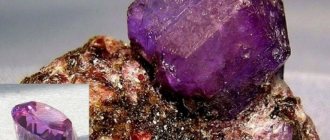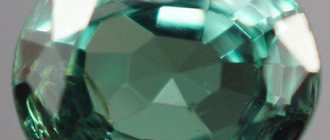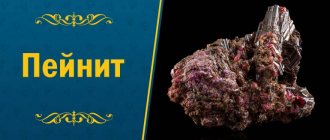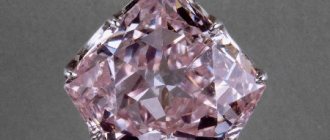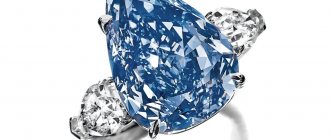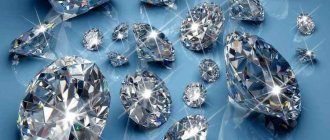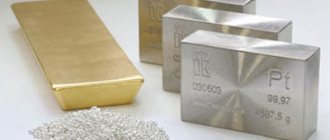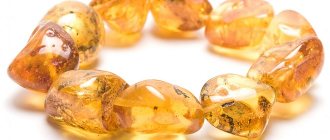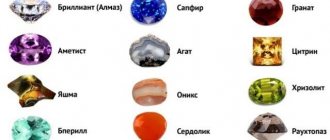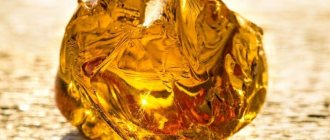List of the rarest stones on the planet
Red diamond
The most valuable and expensive stones on the planet are divided into two types:
- Precious minerals.
- Semi-precious treasures of the earth's interior.
Gems
Rare gems and minerals are a fascinating sight. After all, these antiques of the future may soon disappear altogether.
The deposits of the rarest jewelry are found only in some places in the vast expanses of the planet. And their number is very limited. And the cost of such a shortage will simply shock many inhabitants of the Earth.
We present to our readers a list of the rarest stones in the world:
- Red diamond is the most expensive and rare stone in the whole world. Its deposit is found only in one place on the planet - Australia, and its price is $1 million per 1 carat.
- Grandidierite takes an honorable second place in cost and rarity. This is a transparent stone that contains iron. Its distinctive feature is the ability to shimmer with 3 colors at once: white, green and pale blue. There are only 8 copies of the gem in the world. The cost is 100 thousand dollars per 1 carat.
- Padparadscha is a stone of unusual beauty that shimmers with a varied sunny palette: red, delicate pink and original salmon. The name of the stone literally translates as “sunrise”. It is mined in only 2 places. The price of the stone is 30 thousand dollars per 1 carat.
Padparadscha
- Jadeite is a talisman and sacred stone of the Aztecs. It is used to make a Buddha figure in Thailand. The cost of the jewelry is 20 thousand dollars per 1 carat.
- Diamond. Experiments and research have proven that such a mineral is the hardest on the entire planet. The cost of its highest quality specimens is 15 thousand dollars per 1 carat.
- A ruby is worth the same as a diamond. The stone is distinguished by its rich bloody hue.
- Paraiba tourmaline is an extraordinary stone of bright turquoise color. Its characteristic feature is the ability to glow with electric neon light.
- Alexandrite is notable for its ability to change color depending on the lighting. The price of such a gem ranges from 10 to 37 thousand dollars per 1 carat.
- Bixbite is a stone from the beryl category. It is mined in the USA. Its price is 10 thousand dollars per 1 carat.
- Emerald and sapphire. It is no coincidence that these two stones are listed under the same number, it’s just that their cost is exactly the same: from 6 to 8 thousand per 1 carat. Only sapphire has a beautiful blue color, and emerald has a rich green color.
Another very expensive and rare jewel is natural pearls. It is not without reason that we did not include it in the list of the most expensive and rare stones, since scientists have differing opinions about pearls. Everyone considers it valuable and rare, but some scientists do not classify it as a stone because of its organic origin. Pearls are obtained from mollusk shells and are produced by the mollusks themselves. Pearls also come in different varieties; the most expensive and rare variety is the South Sea pearl.
Jade
Semi-precious
Semi-precious minerals are also very popular, and the demand for them in the jewelry industry is even greater than for elite expensive stones. The price of such products is lower, and a larger number of the planet’s population can afford to pamper themselves with semi-precious goods.
The name of such minerals is known to many:
- Aquamarine completely lifts the veil on its beauty after processing. Its main feature is its delicate turquoise translucent tint. The cost of such a stone is estimated at 30-60 dollars per carat.
- Amethyst is the most expensive variety of quartz. The “Siberian” type of amethyst is especially valued. This is a stone with a deep purple hue and costs $10 per carat.
- For thousands of years, turquoise has held a leading position in the ranking of popular preferences among semi-precious stones. The most expensive varieties are those with a bright blue tint; the price per carat weight for them is $25.
- Demantoid is an unsurpassed emerald from the garnet category. It costs from 100 to 500 dollars per carat.
- Grossular has a number of common features with demantoid. Its price starts at $700 per carat.
- Cat's eye is valued in a variety with a stripe inside the stone, which visually moves depending on the light directed at it and the side of inspection. In terms of strength, a cat's eye is not inferior to a ruby; it costs $45 per carat.
Maltese megalithic temples
Malta
There is so much interesting on the miniature islands of Malta that there is enough for two weeks of an eventful vacation. Start with Ggantija, the oldest of the local megalithic complexes. The two temples and the wall around them predate the Egyptian pyramids. All this is made of huge stone blocks, which, according to legend, were carried on the shoulders of ancient giants.
If you like it, set aside time for the rest of the temples. Hajar Qim, Mnajdra, Ta' Hajrat, Sorrow and Tarxien are all protected by UNESCO. In Tarxien, you won’t miss the remains of a skatua with thick legs - this is one of the Paleolithic Venuses. And to get better acquainted with the prehistoric standards of female beauty, go to the Museum of Archeology: a full-length figurine of an obese Venus is kept there.
Don't miss: 14 Ways to Experience Malta Cave Life: The World's Most Amazing Rock Cities
The rarest minerals and their deposits
Bixbit
All over the world there are only a few varieties of the rarest jewelry, the number of which does not exceed ten pieces, and their appearance is in danger of extinction in the near future. These are:
- Painite was discovered in Burma in 1956. It was immediately included in the list of rare finds in the Guinness Book of Records. The color palette ranges from red to brown, and there are also very rare examples of a delicate pink palette. The mineral deposits are located in two small towns - Kachin and Mogok.
- Tanzanite was discovered in Merelani Hill in Tanzania. The stone has a rich violet-blue palette.
- Benitoite is very similar to sapphire and has a rich blue tint. The deposits are located in California.
- Poudretteite is a rare pink stone, deposits of which are found only in Canada.
Megaliths in the Lore Lindu National Park
Sulawesi Island, Indonesia
Four hundred megaliths are hidden in Lore Lindu National Park on the island of Sulawesi. The most noticeable is the 4.5-meter “Palindo” with round eyes and an enlarged phallus. The smaller idol lies in the rice field: as if hidden and spying. In addition to human figures, the park is full of stone jugs and disks, which apparently served as lids. Nothing is known exactly about these megaliths. And finding them is not easy: in order not to get lost among the forested hills, it is better to call a guide for help. If you're lucky, along the way you'll see the Babirussa fanged pig and Tonk macaques - they live only in Sulawesi.
See also: The most unusual zoos in the world
Rare stones of Russia
Our country is also very rich in natural resources, including the precious category.
The rarest minerals that are found in the depths of our country include:
- Majorite is a deep purple mineral. Only a few such stones were discovered in the Urals.
- Eremeevit was found in Transbaikalia. It has a pale color palette: colorless, yellow, blue.
- Pink topaz was discovered in the Chelyabinsk region. Its main feature is the loss of color when exposed to sunlight.
- Xenotime was discovered in the Astafievskoye deposit and in Miass. Its color varies from brown to black.
- Tazheranite was discovered in the Baikal region. Its color palette varies from orange to red.
Dolmens on the Zhane River
Gelendzhik, Russia
To see dolmens, you don’t have to travel halfway across the Earth. On the Zhane River near Gelendzhik a whole family of ancient tombs awaits you. Round dolmens are made of stone blocks the size of a chest. Rectangular - made of five giant slabs, which raise only one question: how could it even be built? Official science is limited to the funeral version, and you look for yourself and decide what to believe in - in the observatory or in the relay of magical energy.
Don't miss: From Sochi to Elbrus: 16 reasons to go to the Russian Caucasus
Extraction methods
In terms of the method of mining, Russia is not in a leading position. This is due to some downtime in technological and technical development in the period after the 80s and 90s. In this regard, foreign companies are involved in many projects related to the maintenance, development and technical completion of the extraction of certain fossil materials. The most common ways are:
- Open or so-called career method.
- Closed, also known as a mine.
- Combined, combining the features of the first two.
- Drazhny.
- Geotechnological.
- Borehole.
Related materials
00:00 — March 11, 2018
Tunnel to nowhere
Trump's greed will collapse the American economy.
In 2021, diamond demand growth will be between two and four percent. The main growth drivers will be the US and Chinese markets. At the same time, global diamond production in 2021 will decrease by 3.4 percent against an increase of 11.7 percent last year. Industry giants will have to clear up their reserves if they expect to maintain market share and grow profits.
The Russian industry should better insure its own risks - the accident at the Mir mine could not have been a big surprise for the company: the mining and processing plant has been operating for more than 50 years, accordingly, the company must calculate such outcomes. The government should probably reconsider privatization plans while the company's shares are at record levels. Positive changes are taking place in the diamond cutting market, which are contributing to the development of the industry, but their implementation is taking a very long time - at the current pace, Russia will not soon become a competitor to India in the cutting market.
Newgrange Tomb
Ireland
The landowner sent workers to dig up stones on the hill, and they stumbled upon the entrance to the dungeon. This is how Newgrange was discovered, a corridor tomb that turned out to be older than Stonehenge. Outside it is a large mound surrounded by a ring of stones. And inside, along a narrow corridor you find yourself in a burial chamber. Natural light penetrates inside for only 17 minutes a year - during the winter solstice. If you want to get to Newgrange on this very day, take part in the lottery - what if you get lucky? If you arrived at a different time, it’s no problem: in your presence, the lights in the tomb will be turned off, and the light of a lamp will shine through the window. This performance is no less impressive than the real solstice.
Fuel resources
Russia occupies a leading place in the world in reserves of oil, gas, coal and other types of combustible minerals. The country is fully self-sufficient in fuel resources and exports large quantities. According to experts, general geological fuel reserves in Russia will last for more than one century, but not all of them can be explored and extracted.
Oil and gas
In terms of the presence of these minerals, Russia is among the top ten world leaders, and in terms of the amount of gas produced it has a stable lead. A quarter of oil reserves and half of blue fuel reserves are concentrated within the Arctic shelf.
The Inexhaustible Giant
The largest oil field in Russia is Samotlor . Its reserves are estimated at 7.1 billion tons. During the operation of the site (from 1965 to the present day), more than 2.3 billion tons of “black gold” were extracted from its depths. The largest gas field is Urengoyskoye . The reserves of blue fuel here exceed 10 trillion m3 (3rd place in the world). The importance of the deposits is evidenced by the fact that cities were specially built next to them: Nizhnevartovsk near Samotlor and Novy Urengoy near Urengoy. The first is considered the oil capital of Russia, the second - the gas capital.
Coal
Open-pit coal mining accounts for two-thirds of the total volume.
Russia has deposits of brown and hard coal, as well as anthracite, and occupies one of the leading places in the world in terms of their reserves. The total geological resources of these minerals in the country are 157,010 million tons, 69% of which are brown coal. The richest coal basins are Kuznetsk (one of the largest in the world; hard and coking coal), Kansko-Achinsk (leader in brown coal reserves), Pechora and South Yakutsk. A significant part of the reserves of this fuel resource, 95%, is concentrated in the east of the state, 60% of which is in Siberia.
Oil shale
There are especially many deposits of this mineral in the Samara and Leningrad regions. For now, oil shale is being considered as an alternative fuel source. Perhaps their use will intensify when deposits of other types (oil, gas, coal) are exhausted.
Peat
The Vasyugan swamps are a source of high-quality peat.
In Russia, more than 46 thousand deposits of this type of fuel are known, the reserves of which are estimated at 160 billion tons. The largest number of peat deposits are concentrated in the north-west of the European part of the country, the Northern Urals and Western Siberia.
general information
Russia, having the largest territory in comparison with other countries, occupies a leading position in the extraction of essential minerals. The total number of deposits is more than 200,000, and this number is constantly increasing as methods for searching for new deposits are improved. The value of the estimated resources is over 30 trillion. dollars. The amount of natural gas and coal beats the records of most other countries: they represent 32% and 30%, respectively, of the total world reserves.
